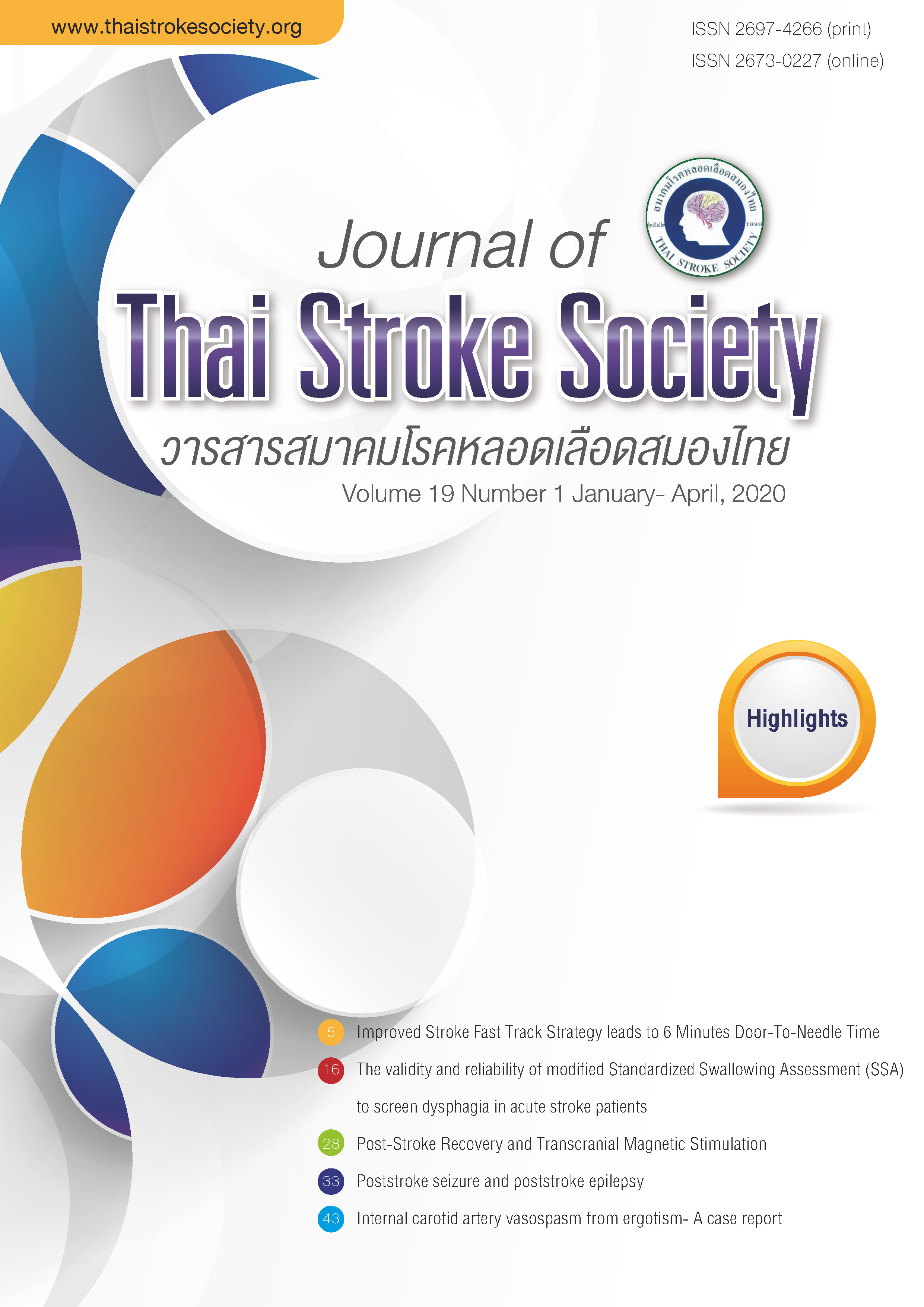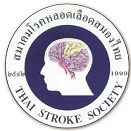Poststroke seizure and poststroke epilepsy
Keywords:
epilepsy, poststroke seizure, seizure, strokeAbstract
Stroke is one of the common causes of acute symptomatic seizure and poststroke epilepsy. Stroke-related disabilities and seizures result in increased morbidity, and mortality. Seizures occur within 7 days of stroke onset are classified as early poststroke seizure or acute symptomatic seizure. The occurrence of seizures after 7 days is classified as late poststroke seizure or poststroke epilepsy. To date, pathophysiologic processes involving in the development of each condition is not well-established, and probably be different. Acute symptomatic seizure is due to the consequence of local metabolic disturbances without altered
neuronal networks. But, the development of poststroke epilepsy may be involved by multi-factorial processes after stroke such as inflammation, metabolic and structural changes of the brain, and remodeling of synaptic networks. These predisposing factors finally resulted in the ongoing process of epileptogenesis and poststroke epilepsy. Overall, poststroke seizures is well-controlled by antiepileptic drug monotherapy. To best of our knowledge, there has not been enough information to prevent the occurrence of seizures after stroke, and stop the epileptogenesis in poststroke epilepsy. Over the past decades, there has been markedly rapid
growing in knowledge and management of acute stroke. But less is known about poststroke seizure and poststroke epilepsy. This review summarizes recent advances in our understanding of poststroke seizure and epilepsy and also provides an update on current understanding of pathogenesis, epidemiology, risk factors, and management issues such as diagnosis, AEDs selection, and prognosis.
References
2. Strategy, M.o.P.H.B.o.P.a., จำนวนและอัตราตายต่อประชากร 100,000 คน จำแนกตามสาเหตุที่สำคัญ พ.ศ.2550-2554. 2011.
3. Krueger H, Koot J, Hall RE, O’Callaghan C, Bayley M, Corbett D. Prevalence of individuals experiencing the effects of stroke in Canada: trends and projections. Stroke 2015; 46: 2226–2231.
4. DeLorenzo RJ, et al. A prospective, population-based epidemiologic study of status epilepticus in Richmond, Virginia. Neurology. 1996 Apr;46(4):1029-35.
5. Forsgren L, et al. Incidence and clinical characterization of unprovoked seizures in adults: a prospective population-based study. Epilepsia. 1996 Mar;37(3):224-9.
6. Fisher RS, Acevedo C, Arzimanoglou A, et al. ILAE official report: a practical clinical definition of epilepsy. Epilepsia 2014; 55: 475–482.
7. Hesdorffer DC, Benn EK, Cascino GD, Hauser WA. Is a first acute symptomatic seizure epilepsy? Mortality and risk for recurrent seizure. Epilepsia 2009; 50: 1102– 1108.
8. Ferlazzo E, Gasparini S, Beghi E, et al. Epilepsy in cerebrovascular diseases: review of experimental and clinical data with meta-analysis of risk factors. Epilepsia 2016; 57: 1205–1214.
9. Bladin CF, Alexandrov AV, Bellavance A, et al. Seizures after stroke: a prospective multicenter study. Arch Neurol 2000; 57: 1617–1622.
10. Burn J, Dennis M, Bamford J, Sandercock P, Wade D, Warlow C. Epileptic seizures after a first stroke: the Oxfordshire Community Stroke Project. BMJ 1997; 315: 1582–1587.
11. Giroud M, et al. Early seizures after acute stroke: a study of 1,640 cases. Epilepsia 1994 Sep-Oct;35(5):959-64.
12. Lancman ME, et al. Risk factors for developing seizures after a stroke. Epilepsia 1993 Jan-Feb;34(1):141-3.
13. Pande D, et al. Post-stroke seizure-Do the locations, types and managements of stroke matter?. Epilepsia Open. 2018 Jul 31;3(3):392-398.
14. Tan TY, Lu CH, Chuang HY, et al. Long-term antiepileptic drug therapy contributes to the acceleration of atherosclerosis. Epilepsia 2009; 50: 1579–1586.
15. Katsiki N, Mikhailidis DP, Nair DR. The effects of antiepileptic drugs on vascular risk factors: a narrative review. Seizure 2014; 23: 677–684.
16. Leung T, Leung H, Soo YO, Mok VC, Wong KS. The prognosis of acute symptomatic seizures after ischaemic stroke. J Neurol Neurosurg Psychiatry 2017; 88: 86–94.
17. Hsu CJ, Weng WC, Peng SS, Lee WT. Early-onset seizures are correlated with late-onset seizures in children with arterial ischemic stroke. Stroke 2014; 45: 1161– 1163.
18. Fox CK, Glass HC, Sidney S, Lowenstein DH, Fullerton HJ. Acute seizures predict epilepsy after childhood stroke. Ann Neurol 2013; 74: 249–256.
19. Kammersgaard LP, Olsen TS. Poststroke epilepsy in the Copenhagen stroke study: incidence and predictors. J Stroke Cerebrovasc Dis 2005; 14: 210–214.
20. Zhang C, Wang X, Wang Y, et al. Risk factors for post-stroke seizures: a systematic review and meta-analysis. Epilepsy Res 2014; 108: 1806–1816.
21. Pitkanen A, Loscher W, Vezzani A, et al. Advances in the development of biomarkers for epilepsy. Lancet Neurol 2016; 15: 843–856.
22. Myint PK, Staufenberg EF, Sabanathan K. Post-stroke seizure and post-stroke epilepsy. Postgrad Med J 2006; 82: 568–572.
23. Belcastro V, Vidale S, Gorgone G, et al. Non-convulsive status epilepticus after ischemic stroke: a hospital-based stroke cohort study. J Neurol 2014; 261: 2136–2142.
24. Cleary P, Shorvon S, Tallis R. Late-onset seizures as a predictor of subsequent stroke. Lancet 2004; 363: 1184– 1186.
25. Silverman IE, Restrepo L, Mathews GC. Poststroke seizures. Arch Neurol 2002; 59: 195–201.
26. Marchi N, Granata T, Ghosh C, Janigro D. Blood-brain barrier dysfunction and epilepsy: pathophysiologic role and therapeutic approaches. Epilepsia 2012; 53: 1877– 1886.
27. Iijima T, Mies G, Hossmann KA. Repeated negative DC deflections in rat cortex following middle cerebral artery occlusion are abolished by MK-801: effect on volume of ischemic injury. J Cereb Blood Flow Metab 1992; 12: 727–733.
28. Williams AJ, Tortella FC. Neuroprotective effects of the sodium channel blocker RS100642 and attenuation of ischemia-induced brain seizures in the rat. Brain Res 2002; 932: 45–55.
29. Kamp MA, Dibue M, Schneider T, Steiger HJ, Hanggi D. Calcium and potassium channels in experimental subarachnoid hemorrhage and transient global ischemia. Stroke Res Treat 2012; 2012: 382146.
30. Maggio N, Shavit E, Chapman J, Segal M. Thrombin induces long-term potentiation of reactivity to afferent stimulation and facilitates epileptic seizures in rat hippocampal slices: toward understanding the functional consequences of cerebrovascular insults. J Neurosci 2008; 28: 732–736.
31. Li S, Overman JJ, Katsman D, et al. An age-related sprouting transcriptome provides molecular control of axonal sprouting after stroke. Nat Neurosci 2010; 13: 1496–1504.
32. Galovic M, Dohler N, Erdelyi-Canavese B, et al. Prediction of late seizures after ischaemic stroke with a novel prognostic model (the SeLECT score): a multivariable prediction model development and validation study. Lancet Neurol 2018; 17: 143–152.
33. Strzelczyk A, Haag A, Raupach H, Herrendorf G, Hamer HM, Rosenow F. Prospective evaluation of a post-stroke epilepsy risk scale. J Neurol 2010; 257: 1322– 1326.
34. Haapaniemi E, Strbian D, Rossi C, et al. The CAVE score for predicting late seizures after intracerebral hemorrhage. Stroke 2014; 45: 1971–1976.
35. De Reuck JL. Stroke-related seizures and epilepsy. Neurol Neurochir Pol 2007; 41: 144–149.
36. Connolly ES Jr, Rabinstein AA, Carhuapoma JR, et al. Guidelines for the management of aneurysmal subarachnoid hemorrhage: a guideline for healthcare professionals from the American Heart Association/American Stroke Association. Stroke 2012; 43: 1711–1737.
37. Qian C, Lopponen P, Tetri S, et al. Immediate, early and late seizures after primary intracerebral hemorrhage. Epilepsy Res 2014; 108: 732–739.
38. Belcastro V, Vidale S, Pierguidi L, et al. Intravenous lacosamide as treatment option in post-stroke non convulsive status epilepticus in the elderly: a proof-of-concept, observational study. Seizure 2013; 22: 905–907.
39. Shetty AK. Prospects of levetiracetam as a neuroprotective drug against status epilepticus, traumatic brain injury, and stroke. Front Neurol 2013; 4: 172.
40. Tanaka T, Ihara M. Post-stroke epilepsy. Neurochem Int 2017; 107: 219–228.
41. Cai PY, Bodhit A, Derequito R, et al. Vagus nerve stimulation in ischemic stroke: old wine in a new bottle. Front Neurol 2014; 5: 107.
42. Meyers EC, Solorzano BR, James J, et al. Vagus nerve stimulation enhances stable plasticity and generalization of stroke recovery. Stroke 2018; 49: 710–717.
43. Gasparini S, Ferlazzo E, Beghi E, et al. Epilepsy associated with leukoaraiosis mainly affects temporal lobe: a casual or causal relationship? Epilepsy Res 2015; 109: 1–8.
Downloads
Published
How to Cite
Issue
Section
License
ข้อความภายในบทความที่ตีพิมพ์ในวารสารสมาคมโรคหลอดเลือดสมองไทยเล่มนี้ ตลอดจนความรับผิดชอบด้านเนื้อหาและการตรวจร่างบทความเป็นของผู้นิพนธ์ ไม่เกี่ยวข้องกับกองบรรณาธิการแต่อย่างใด การนำเนื้อหา ข้อความหรือข้อคิดเห็นของบทความไปเผยแพร่ ต้องได้รับอนุญาตจากกองบรรณาธิการอย่างเป็นลายลักษณ์อักษร ผลงานที่ได้รับการตีพิมพ์ในวารสารเล่มนี้ถือเป็นลิขสิทธิ์ของวารสาร





